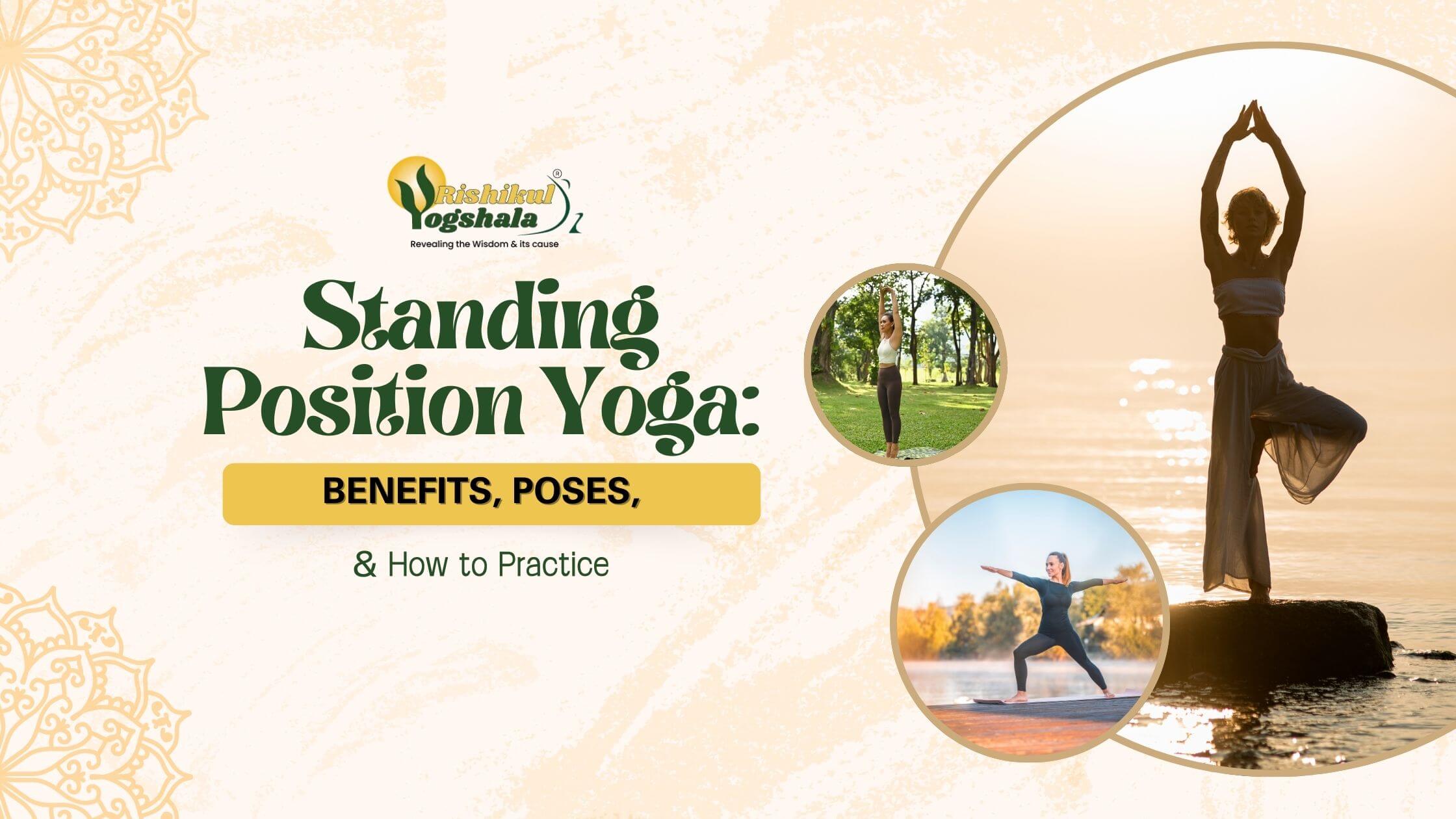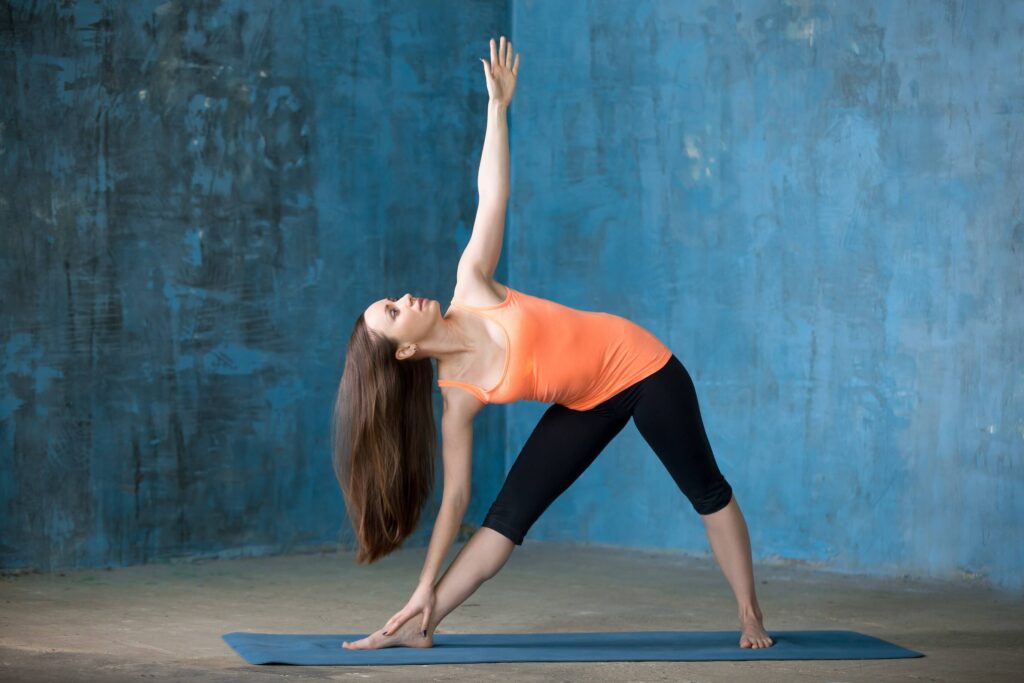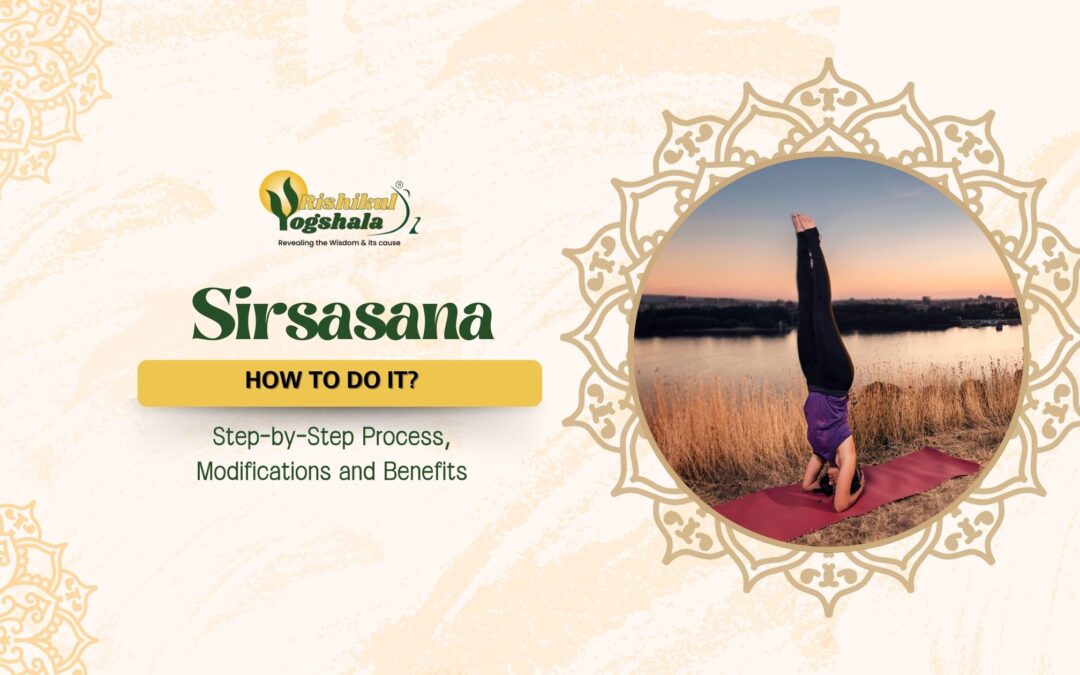Standing Position Yoga: Benefits, Poses, and How to Practice
- Blog
- /
- Yoga Poses and Sequences
- /
- Standing Position Yoga: Benefits,...

Yoga as a practice is very good for the mind, body, and soul. It helps to remove stress and enhance mental well-being. While yoga will surely improve flexibility, it’s also a great way to build strength and stability in the body. In yoga, not all poses may improve flexibility, but certain standing yoga asanas are very helpful for building stability. Let us elaborate on the benefits of standing-position yoga
What are Standing Yoga Poses?
Standing yoga poses can be done on their own, and have several benefits for your body and mind. This will help in building core strength to improve overall stability. Standing position yoga refers to a series of yoga poses that require one to stand and engage the legs, core, and upper body in various ways. These poses can be held for several breaths and can also vary in intensity. The foundation of standing yoga lies in activating the legs and finding balance. It is a great way of improving posture and even breathing!
Why focus on Standing Poses?
Standing poses are typically the core of a well-rounded yoga practice. These poses require endurance, stability, and coordination, making them very useful for developing a strong foundation for all other types of yoga poses. Standing positions are often easier to perform than floor-based poses.
Simple Standing Yoga Poses for Daily Practice
Below are some easy-standing yoga poses for daily practice.
Mountain Pose (Tadasana)
This mountain pose helps strengthen the body and brings awareness to it. This pose can help improve posture as well as strengthen the core, glutes, knees, and ankles.
- Stand with your toes together
- Spread your toes and place your weight through both feet
- Engage the core and tuck your hips under a bit so that your tailbone is pointing down toward the floor
- Inhale and reach your arms overhead
- One can also put their hands in a prayer position in front of the chest.
- Take long, slow, deep breaths

Crescent Lunge
This pose, also known as Anjaneyasana, is a dynamic and energising yoga pose that stretches and strengthens the legs, hips, and core.
- One should bend their front knee and keep their back leg straight
- The heel should be lifted off the floor
- Extend your arms toward the ceiling
- Stretch upward
- Keep at it for 5 to 10 breaths

Lunge with Spinal Twist (Parivrtta Anjaneyasana)
This pose is beneficial for the spine as it helps shift the pressure in your discs, which is very important for a healthy spine.
- Stand with your feet together
- Time to take a step forward with the left foot
- Bend your left knee and then drop into a lunge
- Place your right hand on the floor and twist your upper body to the left
- Hold it for 30 seconds to 2 minutes

Warrior II
This beginner yoga pose strengthens the lower body and opens and lengthens your hips.
- Take a big step forward with your left foot
- Bend your left knee so that it’s at a 90-degree angle
- Point your left toe forward and turn your right foot out to the right
- Twist your torso to the right
- Your left arm and your head should both be pointing forward and the right arm should be pointing back
Triangle Pose
This standing yoga pose focuses on lengthening the spine. It also works your core if you keep your arms outstretched and parallel to the ground.
- Straighten your front leg
- Keep forwarding your left-hand
- Tilt your torso forward
- Rotate your arms to 6 and 12 o’clock.
- Hold for 5 to 10 breaths.

Tree Pose
This very yoga pose strengthens the ankles, opens up your hips, and also helps you tune into your own body awareness.
- Keep yourself in a mountain pose with your toes together
- Then squeeze your foot and inner thigh together at the same time
- The knee of your right leg should be turned out
- Once you’ve found your balance, lift your hands to the prayer position in front of your chest.
- Keep your gaze focused on a fixed point

Warrior III Balance
Warrior 111 activates your core, opens your hamstring, and also builds on the ankle.
- Stand with your right foot on the ground
- Keep your left knee bent
- Straighten your left leg and make your torso parallel to the ground
- Pause for 5 to 10 breaths when the torso is parallel
Who Should Practice Standing Yoga Poses?
- Beginners looking to build strength and stability: Standing yoga can benefit when you’re just starting with a fitness routine. Engaging the legs, core, and back muscles can help beginners build strength and continue with ease.
- Those who struggle with balance and coordination: These very poses improve body awareness and alignment!
- People experiencing lower back discomfort: standing poses reduce strain and improve spinal alignment.
- New mothers recovering post-pregnancy: These poses gently strengthen the lower body, core, and back, thus improving posture affected by carrying and nursing a baby.
- People with sedentary lifestyles: Engaging the leg muscles can help ease stiffness and tightness.
Benefits of Standing Yoga Poses: Easy standing yoga poses for daily practice
- Improves Balance and Stability: Standing yoga poses to strengthen the legs and core.
- Enhances posture alignment: These are standing yoga poses for better posture. Overtime, these poses improve posture and help you to sit and stand together
- Strengthens the core: These poses help to build a stronger core, supporting the lower back and reducing the risk of injury
- Boosts Focus and Mindfulness: Standing yoga poses often require one to gaze at a fixed point. This focus quiets distractions, improves balance, and helps to stay calm.
Expert Tips To Do Standing Yoga Poses Effectively
- Proper alignment is a must for all standing yoga poses. Keep your feet grounded to maintain stability and prevent strain.
- Make sure to engage your core. A strong core will help to enhance balance, improve posture, and help maintain better control over your movements
- If you’re a beginner or are dealing with injuries and pains, use modifications.
- Transition slowly between poses to avoid injury.
Conclusion
Yes, there are many core benefits of yoga standing poses, and if one wants to deepen their yogic practice, then they can avail of courses at Rishikul Yogshala Kerala which include 200 hour yoga ttc in kerala, and 300 hour yoga teacher training india. These yoga courses will help you become experts at yoga and will also help to guide others in their yogic journey.
Some Frequently Asked Questions About Standing Poses in Yoga
1. How to do standing poses if I’m a beginner?
- Use props
- Practice in front of a mirror
- Focus on alignment
2. Can standing poses help with posture?
There are many Benefits of standing position yoga. And yes! Standing poses can help with posture for sure. They can help with straightening your back and your sitting posture. One can practice these Standing yoga poses for better posture
3. Are standing poses good for beginners?
Yes! Many standing poses, such as Mountain Pose, Warrior I, and Warrior II, are great for beginners. They build strength and flexibility in key muscle groups. They also provide a foundation for more advanced poses as your practice deepens.








